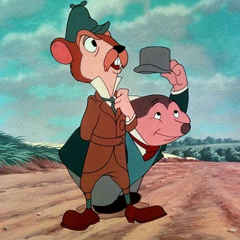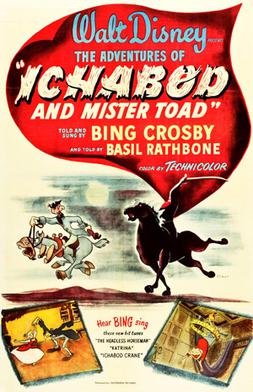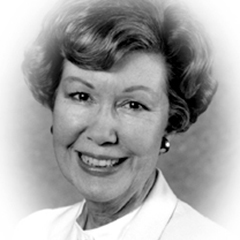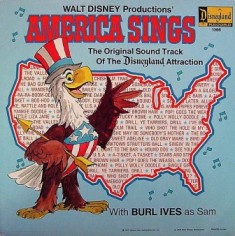It’s Film
Strip Friday!
The
Adventures of Ichabod and Mr. Toad
Release
Date October 5th, 1949

SYNOPSIS:
The Wind in the Willows follows the wild ride of J. Thaddeus
Toad, squire of Toad Hall. Smitten with motorcars, the wealthy and reckless
sportsman soon drives his close friends Mole, Rat, and Angus MacBadger into a
worried frenzy! Then meet Ichabod Crane, the spindly schoolteacher who dreams
of sweeping the lovely Katrina off her feet -- until Brom Bones, the town
bully, gets involved. Their comic rivalry introduces Ichabod to The Legend of
Sleepy Hollow, the fabled Headless Horseman, and a hair-raising, heart-thumping
climax. Narrated by legendary stars Basil Rathbone and Bing Crosby, The
Adventures of Ichabod and Mr. Toad is brimming with high-spirited adventure,
brilliant animation, and captivating music.
FUN FACTS:
The
Adventures of Ichabod and Mr. Toad is a
1949 animated feature produced by Walt Disney. The film was released to
theaters on October 5, 1949 by RKO Radio Pictures and is the eleventh animated
feature in the Walt Disney Animated Classic Series.. The film is also the
finale of the seven package films produced by Disney until The Many Adventures
of Winnie the Pooh in 1977, following Fantasia, Saludos Amigos, The Three
Caballeros, Make Mine Music, Fun and Fancy Free and Melody time.
Segments:
There are two segments in the film, both based upon popular works of literature:
The Wind in the Willows:
The Adventures of Mr. Toad was
based on Kenneth Grahame’s The Wind in the Willows (narrated by Basil Rathbone).
In this story, the charismatic J. Thaddeus Toad, Esq., was the happy-go-lucky,
wealthy proprietor of Toad Hall. Toad believed in fun, adventure and travelling
to "Nowhere in Particular"; He had built a great deal of debt from
disregarding the financial responsibilities of his insatiable love for fads and
"manias", such as recklessly riding through the countryside on a
gypsy cart with his loyal horse, Cyril J. Proudbottom while accidentally crashing
through obstacles. His friends, Ratty (Water Rat), Moley (Mole) and Angus
MacBadger try to talk some sense into him but Toad quickly discovers the
newfangled motor car and is determined to get one by any means necessary. Toad
is charged with car theft after trading the deed to Toad Hall for a car
belonging to Mr. Winky the tavernkeeper and his gang of weasels and thrown in
jail when Winky testifies that Toad tried to sell him a stolen car (which his
cronies actually stole). On Christmas Eve, Cyril visits Toad in disguise and
assists him in escaping. Toad manages to find Ratty and Moley and they are
informed by MacBadger that the evil Winky and his weasels have taken over Toad
Hall. With his friends' aid, Toad redeems his good name by recovering the deed
to the estate from the very hands of its captors. Toad, touched by the loyalty
and kindness of his friends, promises to reform. Ratty, Moley and MacBadger
give a toast to the new Toad at their New Year celebration but are shocked to
find Toad now recklessly flying a 1908 biplane along with Cyril.
The Legend of Sleepy Hallow:
The story of Ichabod Crane and the
Headless Horseman, based on Washington Irving’s The Legend of Sleepy Hallow
(narrated by Bink Crosby). The gangly and lanky Ichabod Crane is the new
schoolmaster in Sleepy Hollow. His somewhat odd behavior makes him the ridicule
of the rambunctious and robust town bully Brom Bones. Despite his odd
appearance, Ichabod quickly proves to be a ladies' man charms all the eligible
local ladies. Finally, however, Ichabod discovers the local town beauty,
Katrina Van Tassel. Katrina is the beautiful young daughter of Baltus Van
Tassel, the wealthiest farmer in the area, and Brom's intended. Katrina is a
coquette by nature, but sees Ichabod as an opportunity to break from the
monotony of Brom scaring away every other potential suitor. Ichabod has his eye
on the Van Tassel wealth, and is infatuated by Katrina's beauty and grace as
well. After a number of comically unsuccessful efforts by Brom to dispose of
Ichabod, the situation changes when Brom decides to take advantage of Ichabod's
strong belief in superstitions. Brom musically tells the tale of the Headless
Horseman to frighten the teacher. That Halloween night, Crane's lonely ride
home becomes exceedingly frightening because of his exposure to the possibility
of encountering the ghost. The atmosphere of fear increases in intensity, until
it breaks the tension at a false alarm, whereupon Ichabod and his horse laugh
hysterically in relief. Immediately, the Headless Horseman appears, laughing
maniacally, riding a large black horse that bears a strong resemblance to the
one owned by Brom. Then follows a chase scene wherein the Horseman pursues
Ichabod with wild abandon, only to be deterred when Ichabod crosses a bridge
near the local Dutch graveyard (the bridge being the point beyond which the
horseman couldn't go, according to the tale). The Horseman then hurls his own
severed head (shown to actually be a fiery Jack-o-lantern),
at Ichabod. The jack-o-lantern bursts into flames as it collides, and
everything fades to black. The next morning, the only things found by the
bridge are a shattered pumpkin and Ichabod's hat. Brom shortly thereafter
marries Katrina. It is later rumored that Ichabod married a rich, plump widow
in a distant county, and had many children (all bearing a resemblance to
Ichabod). But the people of Sleepy Hollow firmly deny this; they all believe
that Ichabod was spirited away on Halloween Night by the ghoulish Headless
Horseman.
Later, this portion of the film was
separated from the companion Mr. Toad film, screened, aired, marketed, and sold
separately as starting in 1958.
The Disney depiction is actually quite
true to Irving's original tale, going as far to have some narrative lines taken
directly from the text. The important elements of classic American Romanticism
are all included, from the in depth description of the natural, frontier-ish
setting of Tarry-Town, to the description of the brackish hero, Brom, and
finally to the element of mystery left to the viewer at the conclusion of the
tale.
Production:
During and after the production of Snow
White and the Seven Dwarfs, Walt Disney searched for stories that he could
adapt into future animated feature films. These films included Pinocchio, Bambi,
Alice in Wonderland, Peter Pan and The Wind in the Willows. Kenneth
Graheme’s 1908 children's book, The Wind in the Willows, with its
anthropomorphised animals could only be produced using animation. Walt Disney
acquired the rights on June 1938. The film was intended to be a single
narrative feature film with the title of the same name.
However, Disney had trouble adapting the
book because it was written as a bedtime story. The filmmakers discovered if
they followed the same approach as the novel had taken the film would become
"slow and boring". Scenes involving Rat and Mole, rowing along the
river, visiting Mr Badger and asking the The Great Pan for help were all
eventually cut and the story became more focused on Toad. Another aspect of the
book that was changed was Mr. Toad stealing the car (and accidentally crashing
it). He was then arrested and inprisioned but escapes (the police strangely are
never re-capture him). However the filmmakers found that the audience had
trouble sympathizing with Toad after committing such a crime, and Walt Disney
feared that the main character of a Disney film stealing a car would "lower
the moral standards of the audience". After much discussion the
Disney's story team reworked the story from Toad stealing the car to him being
framed for Motor vehicle theft by a newly created villain Mr. Winky. Characters
such as Otter, The Rabbits and the Hedgehog children were cut and Mr Badger was
changed to Angus MacBagder who is Scottish rather than English. The artists
also expanded the role of the non-speaking horse that pulls Toad's gypsy wagon
into Cryl Proudbottom. Other scenes included Mr Toad buying several cars,
crashing every single one of them and damaging property. This causes MacBadger
to have a nervous breakdown and to be placed in a sanatorium (at the time the
film made a sanatorium was a place where mentally ill people got rest, today it
is used to describe a psychiatric hospital). After consulting with MacBadger at
the sanatorium, Mole and Ratty lock Toad up in his bedroom, return the car to
the dealer and cut-off Toad's alowence. Toad's escape from his bedroom was much
more elaborate with Toad tricking Mole and Ratty into thinking he has poisoned
himself and whilst Rat, Mole and Cryl raced to get the doctor, toad makes his
escape. When Toad escaped from prison there was a small scene with toad
tricking a washer-woman into giving her clothes so he can escape. These scenes
were later simplified when condensing the story.
By late 1941 a basic script was complete.
Then, in December of that year, the United States became embroiled in World War
II after Pearl harbor was attacked. The US government then commissioned the
Disney studio to produce several propaganda films to help rally support for the
war effort. This contract came at a critical time for the studio, as many of
their animators and other staff had been drafted into the military, and the
studio's ability to produce full-length feature films had been drastically
compromised, resulting in a period of strained finances for most of the 1940s.
Because of this, Wind in the Willows was put on hold until the end of
World War II.
During and after the war, much of
Disney's feature output was made up of so-called "package films".
Beginning with saludos Amigos in 1942, Disney ceased making feature films with
a single narrative, due to the higher costs of such films, as well as the drain
on the studios resources caused by the war.
In 1945, a year after the war Walt
started up production of Wind in the Willows. However, Walt and his
story men found that they had cut so many scenes involving Rat and Mole out of
the film, that the movie only ran for about 45 minutes and it was not long
enough to become a feature film. So Walt and his story team decided that Wind
in the Willows would be better off being part of a package film, all they
had to do was pair it up with another 45 minute story. At first they tried to
pair it as he had tried to pair it up with with Mickey and the Beanstalk
under the title Two Fabulous Characters, and they later tried to add Bongo
under the title Three Fabulous Characters. However, the film was running
too long and Walt decided to cut Wind in the Willows from the film and
retile the Bongo/Mickey and the Beanstalk film, Fun and Fancy Free which was eventually
released in 1947.
Meanwhile, in December 1946, Disney
started production on an new animated feature film, an adaptation of Washington
Irving’s The legend of Sleepy Hallow..
However ,the storyboard artists found that the running time for The Legend
of Sleepy Hollow was about 45 minutes long and was more suited to be a
package film.
Finally, in 1947, Walt Disney decided to
pair Wind in the Willows with The Legend of Sleepy Hollow under
the new working title The Adventures of Ichabod and Mr. Toad. Well-known
celebrities Basil Rathbone and Bing Crosby were cast as narrators in order to
provide mass audience appeal.
The Adventures of Ichabod and
Mr. Toad was the last of the "package" films, and Disney
returned to single narrative features with the 1950's Cinderella.
Awards:
o
Best Cinematography Color - Won
http://disney.go.com/disneyinsider/historyhttp://en.wikipedia.org























